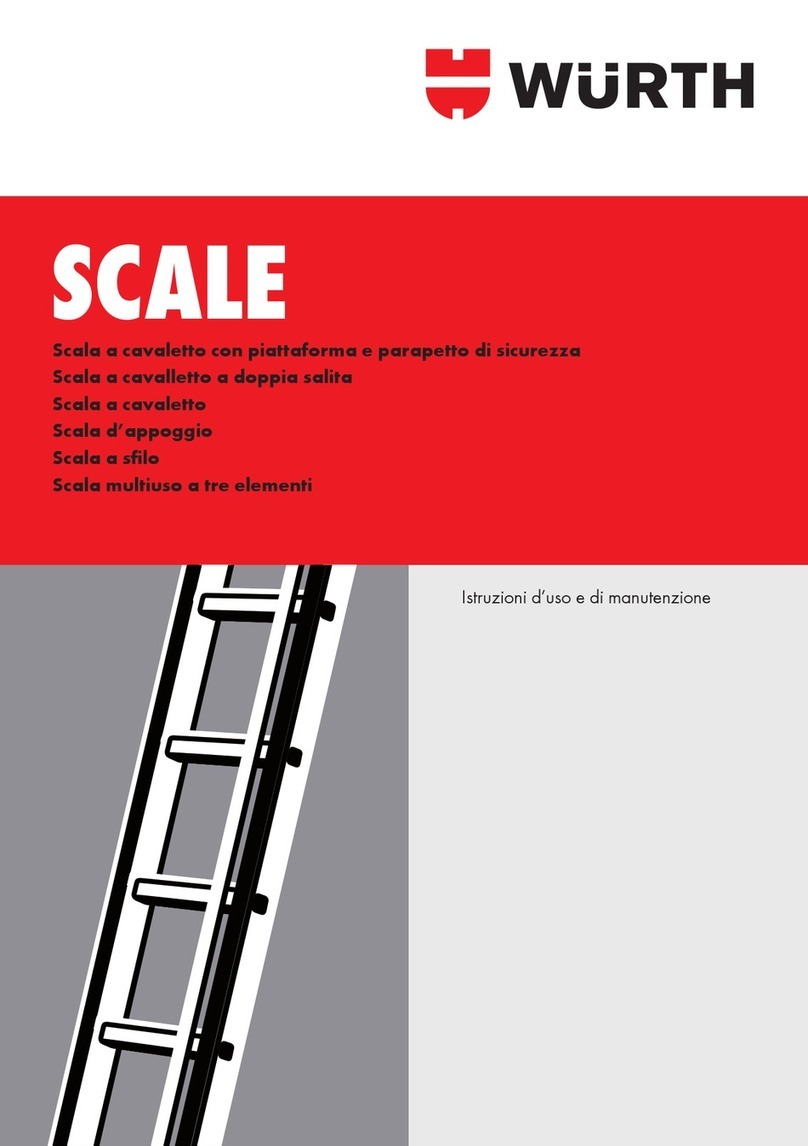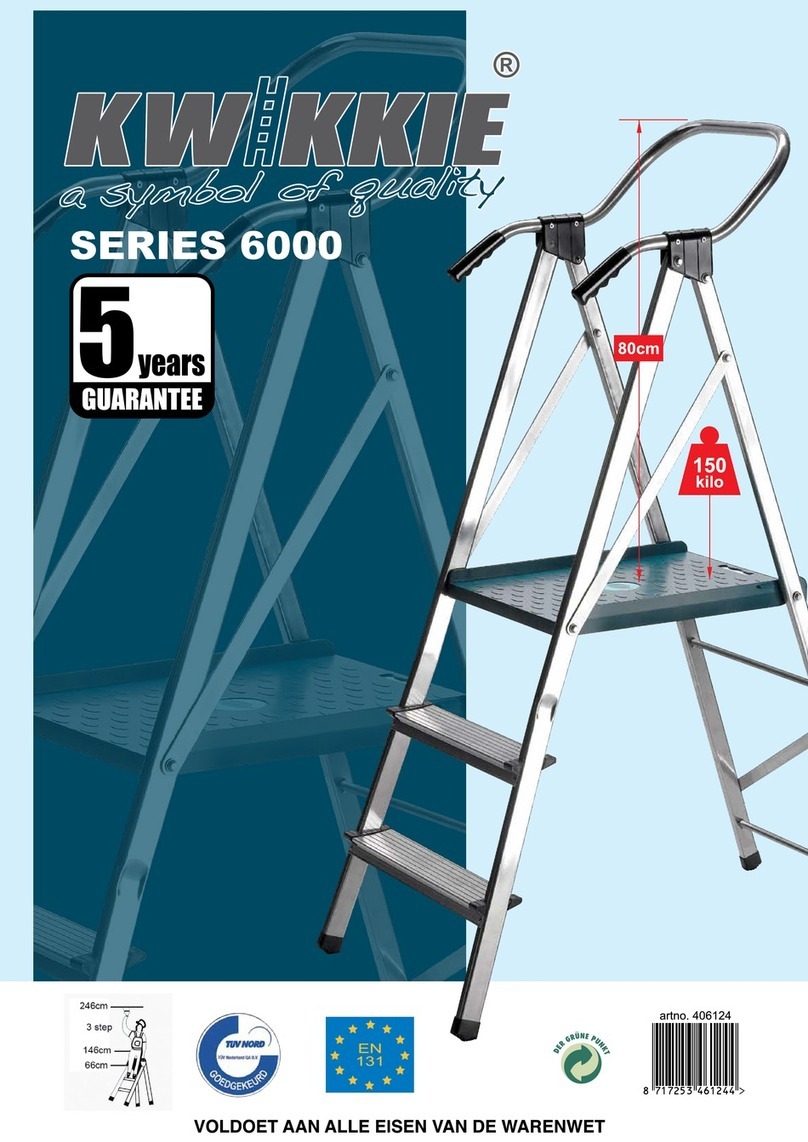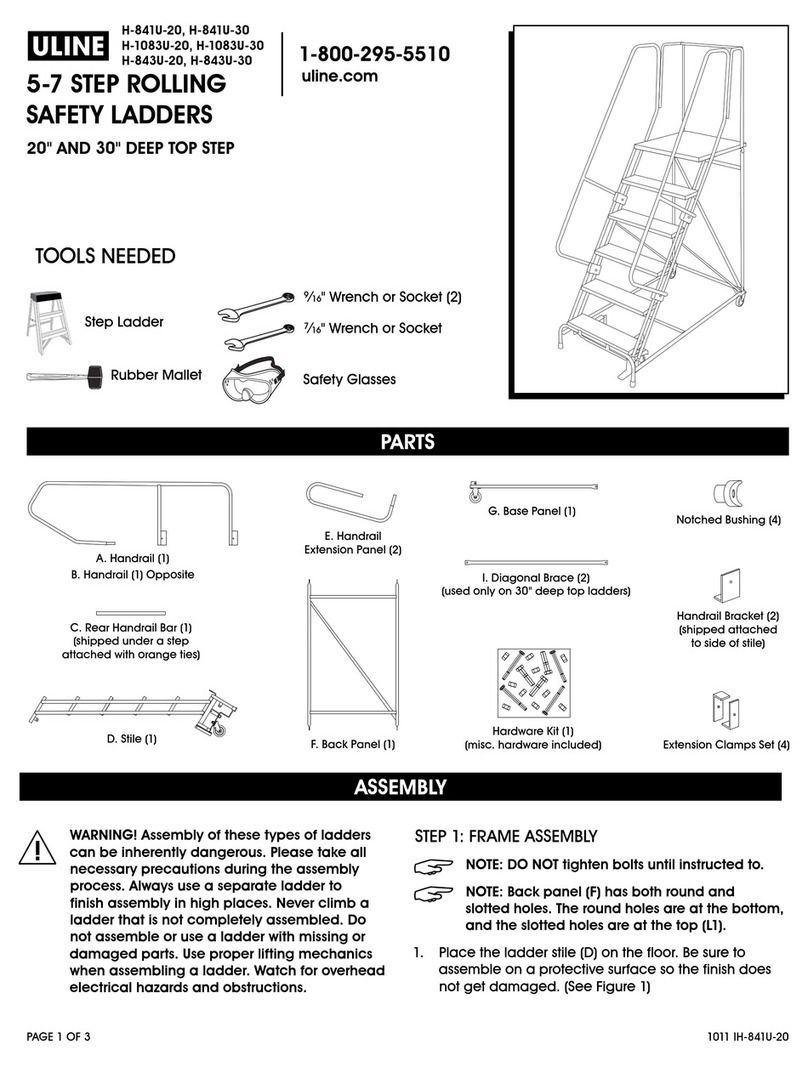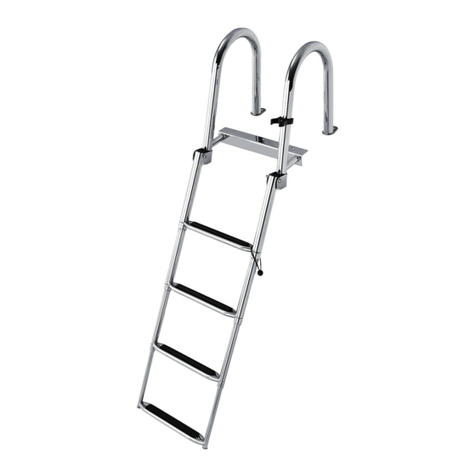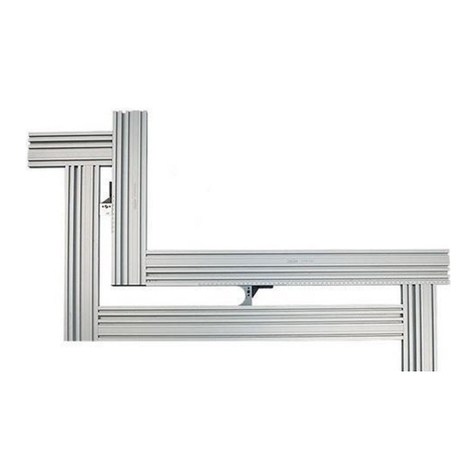Würth 0962 975 23 User manual

1
ISTRUZIONI D'USO
E MANUTENZIONE
Art. 0962 975 23
Istruzioni per l'uso
Gebrauchsanweisung
Instructions

2
N.B: Lavorando ad altezze maggiori di 2 metri si consiglia di mettersi
in sicurezza contro le cadute dall'alto, adottando DPI idonei in quota.
Indicazioni per un corretto impiego
Leggere le istruzioni
© UNI Pagina 16
UNI EN 131-3:2007
APPENDICE A ESEMPI DI PITTOGRAMMI
(informativa)
A.1 Generalità
La presente appendice contiene esempi di pittogrammi per le istruzioni essenziali da
fornire con ogni scala. In questi esempi, i pittogrammi quadrati illustrano un'azione
positiva da eseguire e possono presentare un bordo verde, mentre i pittogrammi rotondi
illustrano un'azione vietata e dovrebbero presentare un bordo rosso.
I pittogrammi riportati nella presente appendice sono forniti solo a titolo di esempio e i
produttori non sono tenuti a conformarsi alla presente norma nella scelta dei pittogrammi.
Si raccomanda di utilizzare pittogrammi conformi alla ISO 3864.
Note Sono in corso di realizzazione pittogrammi conformi alla ISO 3864-1 e alla ISO 3864-2. Questi pittogrammi
saranno inclusi in una futura revisione della presente norma.
A.2 Esempi di pittogrammi
figura A.1 Leggere le istruzioni
figura A.2 Carico massimo
MAX. 150 kg
max.
150 kg
ACAL, C/O API BERGAMO - 2009 - 603499 - eco
© UNI Pagina 26
UNI EN 131-3:2007
figura A.12 Non usare la scala come ponte
figura A.13 Non stare in piedi sul gradino superiore
figura A.14 Controllare i piedi della scala
ACAL, C/O API BERGAMO - 2009 - 603499 - eco
© UNI Pagina 28
UNI EN 131-3:2007
figura A.15 Attenzione ai pericoli di natura elettrica durante il trasporto della scala
figura A.16 Rivolgersi verso la scala per la salita e la discesa
figura A.17 Accertarsi che la scala doppia sia completamente aperta prima dell'uso
ACAL, C/O API BERGAMO - 2009 - 603499 - eco
© UNI Pagina 30
UNI EN 131-3:2007
figura A.18 Numero massimo di utilizzatori sulla scala
figura A.19 Assicurare la sommità/il fondo della scala
figura A.20 Accertarsi che la sommità della scala sia correttamente posizionata
MAX. 1
ACAL, C/O API BERGAMO - 2009 - 603499 - eco
© UNI Pagina 32
UNI EN 131-3:2007
figura A.21 Accertarsi che i dispositivi di sicurezza contro l'apertura siano bloccati
figura A.22 Usare la scala con l'orientamento corretto
ACAL, C/O API BERGAMO - 2009 - 603499 - eco
Carico massimo
© UNI Pagina 16
UNI EN 131-3:2007
APPENDICE A ESEMPI DI PITTOGRAMMI
(informativa)
A.1 Generalità
La presente appendice contiene esempi di pittogrammi per le istruzioni essenziali da
fornire con ogni scala. In questi esempi, i pittogrammi quadrati illustrano un'azione
positiva da eseguire e possono presentare un bordo verde, mentre i pittogrammi rotondi
illustrano un'azione vietata e dovrebbero presentare un bordo rosso.
I pittogrammi riportati nella presente appendice sono forniti solo a titolo di esempio e i
produttori non sono tenuti a conformarsi alla presente norma nella scelta dei pittogrammi.
Si raccomanda di utilizzare pittogrammi conformi alla ISO 3864.
Note Sono in corso di realizzazione pittogrammi conformi alla ISO 3864-1 e alla ISO 3864-2. Questi pittogrammi
saranno inclusi in una futura revisione della presente norma.
A.2 Esempi di pittogrammi
figura A.1 Leggere le istruzioni
figura A.2 Carico massimo
MAX. 150 kg
max.
150 kg
ACAL, C/O API BERGAMO - 2009 - 603499 - eco
Angolo di appoggio
corretto (65 - 75°)
© UNI Pagina 18
UNI EN 131-3:2007
figura A.3 Angolo di appoggio corretto
figura A.4 Montare su una base piana
4x
1x
ACAL, C/O API BERGAMO - 2009 - 603499 - eco
Estensione della scala
oltre il punto di arrivo
min. 1 metro
© UNI Pagina 22
UNI EN 131-3:2007
figura A.7 Montare su una base solida
figura A.8 Estensione della scala oltre il punto di arrivo
figura A.9 Non scendere dal lato della scala
MIN.
1 m
1 m
ACAL, C/O API BERGAMO - 2009 - 603499 - eco
Controllo visivo
prima dell'uso
Controllare i piedi
della scala
Accertarsi che la scala
doppia sia completamente
aperta prima dell'uso
Numero massimo
di utilizzatori sulla scala
Assicurare la sommità/il
fondo della scala
Accertarsi che i dispositivi
di sicurezza contro l'apertura
siano bloccati
© UNI Pagina 24
UNI EN 131-3:2007
figura A.10 Solo una persona sul tronco di salita della scala/scala a gradini
figura A.11 Controllo visivo prima dell'uso
ACAL, C/O API BERGAMO - 2009 - 603499 - eco
Non sporgersi
© UNI Pagina 20
UNI EN 131-3:2007
figura A.5 Non sporgersi
figura A.6 Assicurarsi che non vi sia sporco a terra
OIL H
2
O
ACAL, C/O API BERGAMO - 2009 - 603499 - eco
Assicurarsi
che non vi sia
sporco a terra
Solo una persona sul tronco di
salita della scala/scala a gradini
Non usare la scala come ponte
Non stare in piedi
sul gradino superiore
Accertarsi che i dispositivi
di sicurezza contro l'apertura
siano bloccati
© UNI Pagina 20
UNI EN 131-3:2007
figura A.5 Non sporgersi
figura A.6 Assicurarsi che non vi sia sporco a terra
OIL H2O
ACAL, C/O API BERGAMO - 2009 - 603499 - eco
Montare su una
base solida
© UNI Pagina 22
UNI EN 131-3:2007
figura A.7 Montare su una base solida
figura A.8 Estensione della scala oltre il punto di arrivo
figura A.9 Non scendere dal lato della scala
MIN.
1 m 1 m
ACAL, C/O API BERGAMO - 2009 - 603499 - eco
© UNI Pagina 24
UNI EN 131-3:2007
figura A.10 Solo una persona sul tronco di salita della scala/scala a gradini
figura A.11 Controllo visivo prima dell'uso
ACAL, C/O API BERGAMO - 2009 - 603499 - eco
Montare su
una base piana
© UNI Pagina 18
UNI EN 131-3:2007
figura A.3 Angolo di appoggio corretto
figura A.4 Montare su una base piana
4x
1x
ACAL, C/O API BERGAMO - 2009 - 603499 - eco
© UNI Pagina 18
UNI EN 131-3:2007
figura A.3 Angolo di appoggio corretto
figura A.4 Montare su una base piana
4x
1x
ACAL, C/O API BERGAMO - 2009 - 603499 - eco
© UNI Pagina 18
UNI EN 131-3:2007
figura A.3 Angolo di appoggio corretto
figura A.4 Montare su una base piana
4x
1x
ACAL, C/O API BERGAMO - 2009 - 603499 - eco
© UNI Pagina 30
UNI EN 131-3:2007
figura A.18 Numero massimo di utilizzatori sulla scala
figura A.19 Assicurare la sommità/il fondo della scala
figura A.20 Accertarsi che la sommità della scala sia correttamente posizionata
MAX. 1
ACAL, C/O API BERGAMO - 2009 - 603499 - eco
Non scendere
dal lato della scala
© UNI Pagina 22
UNI EN 131-3:2007
figura A.7 Montare su una base solida
figura A.8 Estensione della scala oltre il punto di arrivo
figura A.9 Non scendere dal lato della scala
MIN.
1 m
1 m
ACAL, C/O API BERGAMO - 2009 - 603499 - eco
© UNI Pagina 26
UNI EN 131-3:2007
figura A.12 Non usare la scala come ponte
figura A.13 Non stare in piedi sul gradino superiore
figura A.14 Controllare i piedi della scala
ACAL, C/O API BERGAMO - 2009 - 603499 - eco
© UNI Pagina 26
UNI EN 131-3:2007
figura A.12 Non usare la scala come ponte
figura A.13 Non stare in piedi sul gradino superiore
figura A.14 Controllare i piedi della scala
ACAL, C/O API BERGAMO - 2009 - 603499 - eco
© UNI Pagina 32
UNI EN 131-3:2007
figura A.21 Accertarsi che i dispositivi di sicurezza contro l'apertura siano bloccati
figura A.22 Usare la scala con l'orientamento corretto
ACAL, C/O API BERGAMO - 2009 - 603499 - eco

3
Rivolgersi verso la scala
per la salita e la discesa
Usare la scala
con l'orientamento
corretto
© UNI Pagina 32
UNI EN 131-3:2007
figura A.21 Accertarsi che i dispositivi di sicurezza contro l'apertura siano bloccati
figura A.22 Usare la scala con l'orientamento corretto
ACAL, C/O API BERGAMO - 2009 - 603499 - eco
Attenzione ai pericoli di natura
elettrica durante il trasporto
della scala
Accertarsi che la sommità
della scala sia correttamente
posizionata
© UNI Pagina 28
UNI EN 131-3:2007
figura A.15 Attenzione ai pericoli di natura elettrica durante il trasporto della scala
figura A.16 Rivolgersi verso la scala per la salita e la discesa
figura A.17 Accertarsi che la scala doppia sia completamente aperta prima dell'uso
ACAL, C/O API BERGAMO - 2009 - 603499 - eco
© UNI Pagina 28
UNI EN 131-3:2007
figura A.15 Attenzione ai pericoli di natura elettrica durante il trasporto della scala
figura A.16 Rivolgersi verso la scala per la salita e la discesa
figura A.17 Accertarsi che la scala doppia sia completamente aperta prima dell'uso
ACAL, C/O API BERGAMO - 2009 - 603499 - eco
© UNI Pagina 30
UNI EN 131-3:2007
figura A.18 Numero massimo di utilizzatori sulla scala
figura A.19 Assicurare la sommità/il fondo della scala
figura A.20 Accertarsi che la sommità della scala sia correttamente posizionata
MAX. 1
ACAL, C/O API BERGAMO - 2009 - 603499 - eco
max 150 kg
60-70˚
max 150 kg
70˚
2a
3
4
611
2b 8 9
10
A B

4
La scala combi è una scala telescopica multifunzione
che può essere usata come scala doppia con o senza
maniglia/appoggio oppure come scala da appoggio.
Grazie alla sua struttura esclusiva, dalla sua lunghezza
totale la scala si ripiega in un formato compatto.
Per mantenere le caratteristiche e la perfetta funzio-
nalità della scala combi, seguire le presenti istruzioni
per l’uso, la cura e la manutenzione.
PERICOLO! La scala combi deve essere
sempre bloccata correttamente prima
dell’utilizzo. Controllare sempre che tutte
le sezioni aperte siano bloccate prima di
salire sulla scala. Non dimenticare di con-
trollare di bloccaggio inferiori, che non
sono visibili dall’alto.
La scala combi si blocca automaticamente all’apertura.
Aprire sempre interamente la scala com-
bi alla lunghezza massima con o senza
maniglia/appoggio. Non sedersi, so-
stare o salire sulla scala combi se non è
completamente aperta e, quando è utiliz-
zata come scala doppia, se i due lati non
sono divaricati e bloccati con il gancio di
fermo.
Come aprire la scala combi:
1 Rimuovere la maniglia di trasporto.
2 Collocare la scala combi su una supercie piana e
resistente. Aerrare i lati della scala e tenere fermi i
due gradini inferiori con un piede mentre si apre la
scala.
a) Aprire come scala doppia con
maniglia/appoggio:
ISTRUZIONI PER L'USO
Apertura della scala
alla lunghezza totale
A
C
E
D
1, 2
3,4
14 15 15 16

5
Aerrare la scala nella parte più alta ed estrarre
interamente la sezione superiore. Continuare ad
estrarre le sezioni una alla volta, nché la scala
combi non è completamente aperta. Controllare
che i bloccaggi si abbassino interamente.
b) Aprire come scala doppia:
Aerrare i lati dei gradini doppi (cerniere) sotto
la maniglia/appoggio ed estrarre interamente
la sezione superiore di entrambi i lati di salita.
Continuare ad estrarre le sezioni una alla vol-
ta, eccetto la maniglia/appoggio, nché i due
lati della scala non sono completamente aperti.
Controllare che i bloccaggi si abbassino intera-
mente.
3 Divaricare i due lati della scala combi. Il nastro
deve essere interamente teso e l’inclinazione del-
la scala deve essere di 70°. Fissare il gancio di
fermo tra i due lati di salita della scala e bloccar-
lo.
4 Accertarsi che tutte le sezioni aperte
siano bloccate: i bloccaggi devono essere in-
teramente abbassati. Per l’uso senza maniglia/
appoggio, non abbassare i bloccaggi superiori
corrispondenti alle sezioni chiuse.
5 All’occorrenza, scuotere la scala in modo che
tutte le sezioni si blocchino.
6 Dopo aver controllato che il gancio di fermo sia
bene inserito e tutte le sezioni siano bloccate in po-
sizione, è possibile utilizzare la scala combi come
scala doppia.
La scala combi può essere utilizzata anche come
scala da appoggio. Trasformare la scala combi in
scala da appoggio nel modo seguente:
7 Aprire la scala come descritto sopra (vedere il
punto A, “Aprire la scala combi come scala dop-
pia”).
8 Sbloccare le sezioni sul lato posteriore della sca-
la premendo uno alla volta i due anelli di bloc-
caggio inferiori.
9 Inclinare la scala combi in avanti. Avvicinare la
sezione inferiore della scala e ssare la cinghia
ai due gradini in modo da tenerli uniti.
10 Accertarsi che tutte le sezioni della parte
anteriore della scala siano bloccate:
i bloccaggi devono essere interamente abbassati.
11 Utilizzare la scala combi come scala da ap-
poggio lasciando pendere la parte posteriore.
Appoggiare la scala con un’inclinazione di 65-
70°.
ATTENZIONE! Appoggiare la scala ad
una supercie liscia e solida e assicurarla
prima dell’utilizzo, ad esempio legando-
la o usando un dispositivo adeguato che
ne garantisca la stabilità.
La scala combi si sblocca con i quattro
bloccaggi inferiori, collocati sotto i penultimi
pioli di ogni lato della scala. Procedere come
segue:
12 Pulire la scala se necessario (vedere sotto).
13 Avvicinare i due lati della scala combi. Se
la scala combi è stata usata come scala da
appoggio, sganciare la cinghia che tiene
assieme i due gradini posteriori.
14 Tenere la scala combi in posizione eretta
e inclinarla allontanandola leggermente
da sé. Aerrare le aste telescopiche. Non
aerrare i pioli, rischio di schiacciamento
durante lo sbloccaggio e la chiusura!
15 Sbloccare per prime le sezioni più
lontane premendo uno alla volta i due
bloccaggi inferiori. Le sezioni si sbloccano
automaticamente. Lo scatto del meccanismo
di bloccaggio è segnalato da una leggera
chiusura della scala. Premere allo stesso
modo entrambi i bloccaggi inferiori del
lato della scala combi più vicino a sé per
sbloccare le altre sezioni. Ora la scala
combi è sbloccata.
16 Inserire con cautela le sezioni una dentro
l’altra.
17 Rimontare la maniglia di trasporto.
ATTENZIONE! Non tenere le mani
sopra o fra le sezioni durante lo
sbloccaggio e la chiusura della scala.
Per motivi di sicurezza e funzionalità, la
scala e in particolare le aste telescopiche
e i pioli devono sempre essere tenuti puliti.
Trasformazione in scala
da appoggio
B
Pulizia
D
Chiusura della scala combi
C

6
Sporcizia, trucioli, macchie di vernice, colla
ecc. devono essere rimossi al termine di ogni
utilizzo e prima di chiudere la scala. Pulire la
scala con un panno e una piccola quantità di
solvente. Dopo la pulizia si possono trattare
le aste telescopiche con spray al silicone
nel seguente modo: nebulizzare le aste ed
asciugare con carta o un panno. La scala
deve essere perfettamente asciutta anché la
polvere non attacchi.
Spostare la scala combi nel formato compatto
utilizzando la maniglia di trasporto in
dotazione.
Agganciare la maniglia di trasporto e tirarla
in alto contro i pioli in modo da distribuire
uniformemente il peso durante il trasporto.
Trasportare sempre la scala combi in posizione
completamente chiusa, nel formato compatto.
In tale modo le aste telescopiche sono protette
da danni e urti che potrebbero pregiudicare
la funzionalità della scala combi. Durante il
trasporto, ssare bene la scala al portapacchi
oppure all’interno del furgone in modo che
non rimanga danneggiata.
La borsa per la scala combi è disponibile
come accessorio.
Riporre sempre la scala combi
• sempre completamente chiusa in formato
compatto
• in un luogo sano (senza umidità, lontano da
fonti di calore, termosifoni ecc)
• in modo che non possa rimanere danneggiata
da veicoli, oggetti pesanti o sostanze
inquinanti
• in un posto in cui non sia d’intralcio e non
costituisca pericolo di inciampamento
• in modo che non possa facilmente essere
usata a scopi criminali, preferibilmente chiusa
con un lucchetto
• se è permanentemente aperta (ad esempio
in un cantiere), fuori dalla portata di persone
non autorizzate (ad esempio bambini).
• Il proprietario della scala deve assicurarsi
che l’utente abbia accesso al manuale per
l’uso.
• Prima del primo utilizzo dopo la consegna,
controllare che la scala sia in buono
stato e che tutte le sue parti funzionino
correttamente.
• La condizione sica dell’utente deve
consentire un utilizzo sicuro della scala:
alune condizioni di salute, assunzione
di medicine, abuso di alcol o di droghe
possono costituire un rischio per la sicurezza.
• Per un uso sicuro della scala, è necessario
ispezionarla ogni volta che la si utilizza,
per vericare che non vi siano componenti
danneggiati da sollecitazioni. Vedere la
sezione “Cura e manutenzione”.
• Se la scala è usata in un contesto
professionale, ispezionarla ad intervalli
regolari.
• Controllare che la scala sia adatta al lavoro
da eseguire.
• Non usare mai una scala danneggiata.
• Rimuovere sporcizia quali vernice fresca,
fango, olio o neve.
• Prima di usare la scala per eettuare un
lavoro, eseguire un’analisi dei rischi e
assicurarsi che siano applicate tutte le
normative in vigore nel Paese in cui ci si
trova.
• La scala può essere usata e riposta a
temperature ambiente da -20° C a +60° C.
• Controllare che la scala sia ben bloccata
prima di usarla.
• Posizionare la scala in modo corretto con
un’inclinazione di 70° rispetto al suolo se
è usata come scala doppia o 60-70° se
è usata come scala da appoggio. I pioli
devono essere orizzontali rispetto al suolo.
• La scala deve poggiare in modo stabile
su una supercie uniforme, orizzontale
e resistente. La scala non deve essere
inclinata lateralmente e nessun piede deve
essere sollevato da terra o appoggiare su
una supercie scivolosa. Se usata come
scala doppia, la scala deve appoggiare
uniformemente su tutti i piedini.
• Appoggiare la scala ad una supercie liscia
e solida e assicurarla prima dell’utilizzo, ad
esempio legandola o stabilizzandola con un
dispositivo adeguato. Non appoggiare la
scala ai pioli ma alle aste
• Non spostare la scala in una nuova
Prima dell'uso
Posizione
Trasporto e stoccaggio
E

7
posizione agendo dall’alto.
• Fare attenzione ai rischi cui sono esposti
pedoni e automobili; non collocare la
scala nelle vicinanze di porte e nestre che
possono venire aperte.
• Identicare tutti i rischi elettrici del luogo di
lavoro, ad esempio condutture in pressione
o altri apparecchi elettronici non protetti.
• La scala deve poggiare sui suoi piedini e
non sui pioli.
• Non appoggiare la scala su superci
scivolose (come ghiaccio, superci lucide o
molto sporche), a meno di non adottare delle
contromisure atte ad impedire che la scala
scivoli, oppure ripulendo accuratamente la
zona.
• La portata massima della scala è 150 kg.
• Non sedersi, sostare o salire sulla scalacombi
se non è completamente aperta con o senza
maniglia/appoggio e, quando è utilizzata
come scala doppia, se i due lati non sono
divaricati e il nastro è teso. Se non sono
bloccate tutte le sezioni, la scala combi è
instabile e pericolosa.
• Quando viene utilizzata come scala da
appoggio, la scala combi deve essere
sempre utilizzata aperta alla lunghezza
totale con il lato posteriore appoggiato
contro la parete/ il supporto. Una sezione
del lato posteriore della scala combi deve
essere sempre ritratta, in modo che la scala
appoggi stabilmente sui piedi anteriori con
la parte posteriore sospesa.
• Non salire sulla parte posteriore della scala
combi quando viene utilizzata come scala
da appoggio.
• Non sostare sui tre pioli superiori quando la
scala combi è usata come scala doppia con
maniglia/appoggio. Sostare sotto lo snodo
a cerniera.
• Non sostare sui due pioli superiori quando la
scala combi è usata come scala doppia
senza maniglia/appoggio. Non sostare
a meno di 600 mm dall’ultimo piolo della
scala.
• Non sostare sui tre pioli superiori quando la
scala è appoggiata alla parete.
• Non usare la scala combi chiusa come
sedile o sgabello.
• Non utilizzare la scala appesa.
• Non aprire, chiudere o utilizzare la scala in
posizione ribaltata.
• Non utilizzare la scala in posizione
orizzontale oppure come ponte.
• Non utilizzare la scala per lavori sporchi
o in ambienti molto sporchi. Se la scala è
utilizzata ad esempio per lavori di muratura,
gettate di cemento o verniciatura, con il
tempo può essere dicile pulirla a fondo e
si può pregiudicare il funzionamento delle
aste telescopiche.
• Non utilizzare la scala in pozzi pieni
d’acqua o simili per prevenire l’ingresso nelle
aste telescopiche di sporcizia che potrebbe
pregiudicare il corretto funzionamento della
scala.
• Trattare la scala con cura, senza sbattere le
aste telescopiche contro corpi contundenti.
Danni alle aste telescopiche pregiudicano il
corretto funzionamento della scala.
• Non sporgersi troppo da un lato. Durante il
lavoro, la bbia della cintura dell’utente deve
trovarsi all’interno dei montanti della scala ed
entrambi i piedi devono sempre poggiare sul-
lo stesso piolo.
• Se si usa la scala per accedere a superci
a grandi altezze, adottare sempre ulteriori
misure di sicurezza, ad esempio legando la
scala o facendo uso di un apposito dispositi-
vo per stabilizzarla.
• Non usare la scala per raggiungere un piano
superiore.
• Usare la scala per lavori leggeri e per breve
tempo.
• Non usare scale in materiale conducente per
i lavori sugli impianti elettrici.
• Non usare la scala all’aperto in caso di cat-
tive condizioni meteorologiche, ad esempio
vento forte.
• Assicurarsi che i bambini non giochino con la
scala.
• Bloccare le porte (tranne le uscite di sicurez-
za) e le nestre del posto di lavoro se pos-
sibile.
• Salire e scendere dalla scala con il viso rivol-
to verso la scala.
• Tenersi bene alla scala quando si sale o si
scende.
• Usare scarpe adatte quando si usa la scala.
• Evitare i lavori che comportano un grande
Utilizzo

8
carico su un lato, ad esempio praticare fori
nel muro o nel calcestruzzo.
• Non sostare per lunghi periodi sulla scala
senza fare pause ad intervalli regolari (la
stanchezza è un rischio).
• Se la scala viene appoggiata al muro per ac-
cedere ad un piano superiore, la scala deve
sporgere di almeno 1 metro sopra il punto di
discesa dell’operatore.
• Usare solo dispositivi leggeri e maneggevoli
quando si lavora sulla scala.
• Tenersi con una mano quando si lavora sulla
scala, oppure adottare altre misure di sicurez-
za se non è possibile tenersi.
Questa scala combinata è un attrezzo di pre-
cisione. Per non pregiudicare le caratteristiche
esclusive della scala, maneggiarla con cura.
La scala combi e, in particolare, le aste telesco-
piche devono essere sempre mantenute pulite.
Non usare la scala combi se priva di piedini
di gomma (protezioni antiscivolo) e protezioni
superiori. Le protezioni superiori impediscono
a polvere, trucioli ecc. di penetrare all’interno
delle aste telescopiche e pregiudicare il corretto
funzionamento della scala. I piedini di gomma
e le protezioni superiori della scala sono sog-
getti a normale usura e possono essere acquis-
tati presso il rivenditore. Sostituire le protezioni
quando mostrano segni di usura. La scala tele-
scopica deve essere riparata solo da personale
qualicato. Non usare la scala telescopica se
deve essere sottoposta a riparazione! Rivolger-
si al rivenditore.
NOTA! Ordinare una nuova etichetta
di avvertimento se l’etichetta inizia
ad essere usurata e dicile da legge-
re. Vedere l’indirizzo sul retro del lib-
retto di istruzioni oppure contattare
il proprio rivenditore autorizzato.
Prima dell’uso controllare che
• le aste telescopiche non siano piegate, torte,
battute, spaccate o corrose
• le aste telescopiche siano integre nei punti di
raccordo
• la viteria (rivetti, viti ecc) non manchino, non
siano allentati e non siano corrosi
• i pioli non manchino, non siano allentati, usu-
rati, corrosi o danneggiati
• i piedini in gomma e le protezioni superiori
non manchino, non siano allentati, usurati,
corrosi o danneggiati
• tutta la scala sia pulita (priva di sporco, fan-
go, vernice, olio o grasso)
• i dispositivi di bloccaggio non siano dann-
eggiati o corrosi e funzionino correttamente.
ATTENZIONE! Se si vericano le con-
dizioni elencate sopra, non usare la
scala.
Il Costruttore garantisce il prodotto per eventu-
ali difetti del materiale o di fabbricazione. Se
è possibile dimostrare difetti del materiale o di
fabbricazione, oppure danni provocati a causa
di tali difetti del materiale o di fabbricazione,
l’acquirente ha il diritto di ottenere la riparazi-
one o la sostituzione del prodotto secondo le
leggi sulla vendita di merci al consumatore in
vigore nel paese di acquisto.
Garanzia estesa
Il Costruttore è responsabile dei difetti del pro-
dotto che si vericano entro un anno dalla data
originale di acquisto.
Campo d’applicazione
Tuttavia la responsabilità del Costruttore deca-
de qualora il difetto possa essere ricondotto a:
• utilizzo in modo diorme da quanto previsto
nelle presenti istruzioni per l’uso;
• pulizia, cura, manutenzione, conservazione e
trasporto in modo diorme da quanto previs-
to nelle presenti istruzioni per l’uso;
• modica, manomissione o altro danno ester-
no o incidente;
• danni involontari causati da oggetti o sostan-
ze estranee;
• sovraccarico;
• riparazione da parte di personale non auto-
rizzato oppure utilizzo di parti di ricambio
non originali;
• installazione errata.
Non sono considerati difetti:
• normale usura
• normale consumo di componenti soggetti a
usura.
Reclami
Anché la garanzia sia valida è necessario
Garanzia
Cura e manutenzione

9
Kombileiter zur
freistehenden
Stehleiter ausziehen
A
Umstellen zur Anlegeleiter
B
mostrare la ricevuta d’acquisto. L’acquirente
deve informare il rivenditore del difetto per il
quale desidera sporgere reclamo entro un ter-
mine congruo dopo la scoperta del difetto op-
pure entro il tempo previsto per legge nel paese
di acquisto.
Assistenza e riparazione
Eventuali operazioni di assistenza o riparazio-
ne devono essere sempre eseguite da un centro
di assistenza autorizzato, che valuterà gli inter-
venti da adottare nel caso specico. In caso di
riparazione vanno utilizzati parti di ricambio
originali. Rivolgersi al rivenditore per indicazi-
oni sul centro di assistenza autorizzato più vici-
no, oppure all’indirizzo riportato a tergo delle
istruzioni per l’uso.
GEBRAUCHSANWEISUNG
Die Kombileiter ist eine Teleskopleiter, die
sich sowohl als freistehende Stehleiter mit oder
ohne Beinstütze/Handgri als auch als Anle-
geleiter nutzen lässt. Durch ihre einzigartige
Konstruktion lässt sie sich aus einem kompakten
Format zur vollen Höhe ausziehen.
Zur Bewahrung der Eigenschaften und Funk-
tionsfähigkeit der Kombileiter ist es von aller-
größter Bedeutung, dass sie wie folgt benutzt,
gepegt und gewartet wird.
Die Kombileiter rastet automatisch ein, wenn sie
ausgezogen wird.
Die Kombileiter muss immer ganz auf
ihre volle Höhe ausgezogen werden,
mit oder ohne Beinstütze/Handgri.
Sie dürfen auf die Kombileiter nicht
hinaufsteigen bzw. darauf sitzen
oder stehen, bevor sie nicht ganz
ausgezogen und – bei der Nutzung
als freistehende Stehleiter – außer-
dem mit dem Schutzriegel vor Zu-
sammenklappen gesichert ist.
Kombileiter wie folgt ausziehen:
1 Tragegri abnehmen.
2 Kombileiter auf einen waagerechten und
harten Untergrund stellen. Leiterseiten zu-
sammenhalten und die beiden untersten Lei-
tersprossen mit einem Fuß unten halten, wäh-
rend die Leiter ausgezogen wird.
a)Zur Stehleiter mit Beinstütze/Hand-
gri ausziehen:
Leiter ganz oben festhalten und das oberste
Sprossensegment vollständig ausziehen. Mit
dem Ausziehen der Sprossensegmente ein-
zeln nacheinander fortfahren, bis die Kombi-
leiter ganz ausgezogen ist. Überprüfen, ob
die Sperrriegel vollständig herunterfallen.
b) Zur Stehleiter ausziehen:
Die Seiten der doppelten Leitersprosse
(Scharniergelenk) unterhalb von Beinstütze/
Handgri festhalten und das oberste Spros-
sensegment beider Leiterseiten ausziehen.
Mit dem Ausziehen der Sprossensegmente
einzeln nacheinander fortfahren, bis beide
Leiterseiten außer dem Beinstützen-/Hand-
gri-Segment ausgezogen sind. Überprüfen,
ob die Sperrriegel vollständig herunterfallen.
3 Beide Leiterschenkel auseinanderklappen.
Das Band muss ganz gestreckt sein und der
Aufstellwinkel 70° betragen. Den Zusammen-
klappschutzriegel zwischen den beiden Leiter-
schenkeln ausklappen und einrasten lassen.
4 Prüfen, ob sämtliche ausgezogenen
Sprossensegmente arretiert sind: Die
Sperrriegel müssen komplett ausgeklappt
sein. Bei der Verwendung ohne Beinstütze/
Handgri werden die obersten Sperrriegel
an den nicht ausgezogenen Sprossenseg-
menten nicht ausgeklappt.
5 Bei Bedarf etwas an der Leiter rütteln, sodass
alle Sprossensegmente in der Verriegelungs-
position einrasten.
6 Wenn überprüft ist, dass der Zusammen-
klappschutzriegel eingerastet ist und alle
Segmente arretiert sind, können Sie die Kom-
bileiter als freistehende Stehleiter benutzen.
Die Kombileiter lässt sich auch als Anlegeleiter

10
verwenden. Das Umstellen von der Kombileiter
zur Anlegeleiter erfolgt folgendermaßen:
7 Leiter wie oben beschrieben ausziehen (sie-
he A „Kombileiter zur freistehenden Stehlei-
ter ausziehen“).
8 Die Sprossensegmente auf der hinteren Leiter-
seite entriegeln, indem Sie die beiden unters-
ten Sperrriegel nacheinander eindrücken.
9 Kombileiter nach vorn kippen. Das unterste
Sprossensegment zusammenschieben und
den Riemen um die beiden Leitersprossen
anziehen, sodass sie zusammengehalten
werden.
10Überprüfen, ob alle Sprossenseg-
mente an der vorderen Seite der
Kombileiter arretiert sind: Die Sperr-
riegel müssen komplett ausgeklappt sein.
11Bei der Nutzung der Kombileiter als Anle-
geleiter lässt man die hintere, zusammen-
geschobene Leiterseite hinunterhängen. Der
Aufstellwinkel der Leiter muss 65–70° betra-
gen.
WARNUNG! Die Anlegeleiter muss
gegen eine ebene und feste Fläche
gelehnt und vor der Benutzung gesi-
chert werden, beispielsweise durch
Festbinden oder eine andere sinnvol-
le Methode, die für Stabilität sorgt.
Die Verriegelung der Kombileiter wird mit den
vier Sperrriegeln ganz unten gelöst, die sich
unter den zweituntersten Sprossen auf jeder
Leiterseite benden. Die Kombileiter wie folgt
zusammenschieben:
12 Falls erforderlich, die Kombileiter reinigen
(siehe unten).
13 Die Kombileiter zusammenklappen. Falls die
Kombileiter als Anlegeleiter verwendet wor-
den ist, zunächst den Riemen lösen, der die
beiden zusammengeschobenen Sprossen
auf der hinteren Seite zusammenhält.
14 Die Kombileiter aufrecht halten und etwas
vom Körper weg neigen. Leiter an den Tele-
skopstangen festhalten (nicht an den Spros-
sen), um zu vermeiden, dass Sie sich beim
Entriegeln und Zusammenschieben der Lei-
ter klemmen.
15 Zuerst die Sprossensegmente am hinteren
Leiterschenkel entriegeln, indem Sie die bei-
den untersten Sperrriegel nacheinander ein-
drücken. Die Arretierung der Sprossenseg-
mente wird automatisch gelöst. Das Lösen
des Verriegelungsmechanismus zeigt sich
dadurch, dass die Leiter etwas zusammen-
rutscht. Die beiden untersten Sperrriegel
auf der Ihnen zugewandten Seite der Kom-
bileiter auf die gleiche Weise eindrücken,
um die Arretierung der übrigen Sprossen-
segmente zu lösen. Die Kombileiter ist jetzt
entriegelt.
16 Die Sprossensegmente vorsichtig ineinan-
der schieben.
17 Tragegri wieder befestigen.
WARNUNG! Die Hände nicht auf
oder zwischen die Sprossensegmen-
te legen, wenn Sie die Leiter entrie-
geln und zusammenschieben.
Aus Sicherheits- und Funktionsgründen ist die
Leiter stets sauber zu halten, insbesondere
die Teleskopstangen und Sprossensegmente.
Schmutz, Späne, Farbspritzer, Klebstoreste
usw. müssen nach jedem Gebrauch vor dem
Zusammenschieben der Leiter abgewischt oder
abgewaschen werden. Die Reinigung erfolgt
mit einem Lappen mit etwas Lösungsmittel.
Nach der Reinigung können die Teleskopstan-
gen mit Silikonspray behandelt werden. Leiter
ausziehen, einsprühen und mit Papier oder ei-
nem Lappen trocknen. Die Leiter muss immer tro-
cken sein, damit kein Staub daran haften bleibt.
Tragen Sie die Kombileiter im kompakten For-
mat an dem losen Tragegri, der im Lieferum-
fang enthalten ist. Den Gri einhaken und nach
oben zu den Sprossen ziehen, um ein Gleich-
gewicht beim Tragen zu erhalten. Die Leiter
im kompakten Format stets komplett zusam-
mengeschoben transportieren. So werden die
Teleskopstangen gegen Stöße und Schäden
gesichert, die die Funktion der Kombileiter be-
Kombileiter
zusammenschieben
C
Reinigung
D
Transport und Lagerung
E

11
einträchtigen können. Sie die Leiter beim Trans-
port sorgfältig auf dem Dachgepäckträger oder
im Lastwagen, sodass sie nicht beschädigt wird.
Eine Tragetasche für die Kombileiter ist als Zu-
behör erhältlich.
Kombileiter wie folgt lagern:
• Vollständig zum Kompaktformat zusammen-
geschoben.
• unter schonenden Bedingungen (nicht zu
hohe Feuchtigkeit, Hitze, Nähe zu Heizkör-
pern etc.),
• ohne Gefahr der Beschädigung durch Fahr-
zeuge, schwere Gegenstände oder Ver-
schmutzung,
• an einem Ort, an dem die Leiter nicht stört
und keine Stolpergefahr darstellt,
• nicht ohne Weiteres für kriminelle Zwecke
nutzbar, gern mit Schloss gesichert,
• geschützt vor unbefugter Anwendung (z. B.
durch Kinder), falls sie dauerhaft aufgestellt
ist (z. B. an einem Baugerüst).
• Der Besitzer der Leiter muss dem Benutzer
das Handbuch zur Verfügung stellen.
• Vor der ersten Verwendung nach Lieferung
muss überprüft werden, ob die Leiter im gu-
ten Zustand ist und alle Teile funktionstüchtig
sind.
• Ihr Gesundheitszustand muss die Nutzung
der Leiter erlauben. Gewisse Gesundheits-
zustände, Arzneimittel und Alkohol- oder
Drogenmissbrauch können Sicherheitsrisiken
verursachen.
• Zur sicheren Nutzung der Leiter muss diese
an jedem Einsatztag inspiziert werden, um
sicherzustellen, dass keine Beschädigung vor-
liegt (siehe „Pege und Wartung“ unten).
• Wenn die Leiter zur Gewerbsarbeit verwen-
det wird, muss sie regelmäßig inspiziert wer-
den.
• Überprüfen Sie, ob die Leiter für die aktuelle
Arbeit geeignet ist.
• Beschädigte Leitern nicht verwenden.
• Verschmutzungen wie feuchte Farbe, Lehm,
Öl und Schnee entfernen.
• Vor Nutzung der Leiter ist eine Risikoanalyse
durchzuführen, und die Bestimmungen des
Landes, in dem sie genutzt wird, müssen be-
achtet werden.
• Die Leiter darf in einer Umgebungstempera-
tur von -20 ° C bis 60 ° C eingesetzt und
gelagert werden.
• Vor der Nutzung überprüfen, ob die Leiter
ordnungsgemäß eingerastet ist.
• Die Leiter muss korrekt aufgestellt werden, mit
einem Neigungswinkel von 70° gegenüber
dem Boden bei Einsatz als Stehleiter bzw.
von 60–70° bei Verwendung als Anlege-
leiter. Die Leitersprossen müssen waagerecht
liegen.
• Die Leiter muss standsicher auf einem ebe-
nen, waagerechten und festen Untergrund
stehen. Die Leiter darf nicht seitlich geneigt
stehen, einen unbelasteten Fuß aufweisen
oder auf nicht rutschfestem Grund aufgestellt
werden. Als Stehleiter muss sie mit gleichmä-
ßiger Belastung auf allen Füßen stehen.
• Die Anlegeleiter muss gegen eine ebene und
feste Fläche gelehnt und vor der Benutzung
gesichert werden, beispielsweise durch Fest-
binden oder eine andere sinnvolle Methode
zur Stabilisierung. Die Leiter nicht mit den
Sprossen, sondern mit den Seitenrohren auf-
legen.
• Die Leiter darf nicht von oben in eine neue
Position gebracht werden.
• Berücksichtigen Sie die Gefahr, dass bei-
spielsweise Fußgänger, Autos oder Türen an
die Leiter stoßen.
• Alle Gefahren durch elektrischen Strom am
Arbeitsplatz identizieren, beispielsweise
Freileitungen und andere ungeschützte Strom-
vorrichtungen.
• Die Leiter darf nur auf ihren Füßen aufgestellt
werden, nicht auf den Sprossen.
• Die Leiter darf nicht auf rutschigem Unter-
grund aufgestellt werden (z. B. Eis, glatte
oder stark verschmutzte Flächen), ohne dass
Maßnahmen gegen ein Verrutschen der Lei-
ter vorgenommen werden oder der Unter-
grund gründlich gereinigt wird.
• Die Leiter darf mit maximal 150 kg belastet
werden.
• Sie dürfen auf die Kombileiter nicht hinauf-
steigen bzw. darauf sitzen oder stehen, bevor
sie nicht ganz ausgezogen ist (mit oder ohne
Beinstütze/Handgri ) und bei der Nutzung
Vor dem Gebrauch
Aufstellen
Gebrauch

12
als freistehende Stehleiter außerdem mit
gestrecktem Band auseinandergeklappt ist.
Wenn nicht alle Sprossensegmente arretiert
sind, ist die Kombileiter instabil und ihre Be-
nutzung gefährlich.
• Als Anlegeleiter muss die Kombileiter beim
Einsatz immer zur vollen Höhe ausgezogen
und mit der Rückseite an die Wand/Anlege-
äche gelehnt sein. Ein Sprossensegment an
der Rückseite der Kombileiter muss immer zu-
sammengeschoben sein, sodass die Leiter mit
frei hängendem Rückteil stabil auf den vorde-
ren Füßen steht.
• Bei Verwendung als Anlegeleiter nicht auf die
Rückseite der Kombileiter steigen.
• Nicht auf den drei obersten Sprossen stehen,
wenn die Kombileiter als Stehleiter mit Bein-
stütze/Handgri genutzt wird. Unterhalb des
Scharniergelenks stehen.
• Nicht auf den zwei obersten Sprossen stehen,
wenn die Kombileiter als Stehleiter ohne Bein-
stütze/Handgri genutzt wird. Nicht näher
als 600 mm an der obersten Leitersprosse
stehen.
• Nicht auf den drei obersten Sprossen einer
Anlegeleiter stehen.
• Die Kombileiter darf in zusammengeschobe-
nem Zustand nicht als Sitz- oder Tritthocker
verwendet werden.
• Die Leiter niemals hängend benutzen.
• Die Leiter nicht auf den Kopf gestellt auszie-
hen, zusammenschieben oder benutzen.
• Die Leiter nicht in waagerechter Position oder
als Brücke benutzen.
• Die Leiter nicht bei Schmutz produzierenden
Arbeiten oder in schmutzigen Umgebungen
verwenden. Wird die Leiter beispielsweise
bei Maurer- oder Betonarbeiten oder beim
Malen verwendet, kann sie mit der Zeit
schwer zu reinigen sein und die Teleskopfunk-
tion beeinträchtigt werden.
• Die Leiter nicht in wassergefüllten Schächten
verwenden, da dadurch Schmutz in die Te-
leskopstangen eindringen und die Funktion
beeinträchtigen kann.
• Die Teleskopstangen vor Stößen schützen
und behutsam handhaben, da Schäden an
den Stangen die Teleskopfunktion beeinträch-
tigen.
• Nicht zu weit zur Seite hinausrecken. Wäh-
rend der gesamten Arbeitszeit muss sich die
Gürtelschnalle (bzw. der Nabel) des Benut-
zers innerhalb der Leiterseiten benden und
beide Füße müssen auf der gleichen Leiter-
sprosse stehen.
• Nicht aus größerer Höhe von einer Anlege-
leiter hinabsteigen, ohne für zusätzliche Absi-
cherung zu sorgen, beispielsweise durch Fest-
binden oder eine andere sinnvolle Methode
zur Stabilisierung.
• Stehleitern nicht dazu verwenden, um auf
eine höhere Ebene zu klettern.
• Leitern sollen nur für kurzfristige, leichtere Ar-
beiten verwendet werden.
• Für elektrische Arbeiten eine nicht leitende
Leiter verwenden.
• Die Leiter bei schlechtem Wetter (z. B. star-
kem Wind) nicht im Außengelände einsetzen.
• Sorge dafür tragen, dass keine Kinder mit der
Leiter spielen.
• Türen (keine Notausgänge) und Fenster am
Arbeitsplatz abschließen, falls möglich.
• Beim Hinauf- und Hinabsteigen der Leiter das
Gesicht zuwenden.
• Beim Hinauf- und Hinabsteigen gut an der
Leiter festhalten.
• Bei der Benutzung der Leiter geeignete Schu-
he tragen.
• Arbeiten vermeiden, die zu große seitliche
Belastung verursachen, wie z. B. Bohren in
Mauerwerk oder Beton.
• Nicht zu lange auf einer Leiter stehen, son-
dern regelmäßige Pausen einlegen (Müdig-
keit ist ein Risikofaktor).
• Eine Anlegeleiter, die zum Erreichen einer hö-
heren Ebene genutzt wird, muss mindestens 1
Meter über den Abstiegsort hinausragen.
• Beim Arbeiten auf der Leiter nur leichte und ein-
fach zu handhabende Ausrüstung verwenden.
• Beim Arbeiten auf der Leiter mit einer Hand
festhalten oder andere Sicherheitsvorkehrun-
gen treen, wenn das nicht möglich ist.
Ihre Kombileiter ist ein Präzisionswerkzeug. Be-
handeln Sie die Leiter daher sorgsam, damit sie
ihre einzigartigen Eigenschaften behält.
Halten Sie die Leiter stets sauber, besonders die
Teleskopstangen.
Die Teleskopleiter darf nicht ohne Gummifü-
ße (Gleitschutz) und Schutzkappen benutzt
werden. Die Schutzkappen verhindern, dass
Pege und Wartung

13
Staub, Bohrspäne o. Ä. in die Teleskopstangen
gelangen und so die Funktion der Leiter beein-
trächtigen. Gummifüße und Schutzkappen sind
Verschleißteile, die im Fachhandel erhältlich
sind. Der Schutz ist auszutauschen, sobald Ver-
schleißerscheinungen auftreten.
Aus Sicherheitsgründen dürfen nur Originalteile
verwendet werden. Die Teleskopleiter muss von
qualiziertem Fachpersonal repariert werden.
Die Teleskopleiter nicht benutzen, wenn sie re-
pariert werden muss. Wenden Sie sich an Ihren
Fachhändler.
ACHTUNG! Bestellen Sie bitte einen
neuen Aufkleber, wenn das Hinweis-
schild an der Leiter abgenutzt und
schlecht zu lesen ist. Bestelladresse
siehe Rückseite der Gebrauchsan-
weisung oder wenden Sie sich an Ih-
ren Fachhändler.
Vor der Benutzung überprüfen:
• Die Teleskopstangen sind nicht gebogen, ver-
dreht, verbeult, gerissen oder korrodiert.
• Die Teleskopstangen sind an den Anschluss-
stellen unbeschädigt.
• Kein Beschlagteil (Nieten, Schrauben usw.)
fehlt, ist locker oder korrodiert.
• Keine der Sprossen fehlt, ist locker, abge-
nutzt, korrodiert oder beschädigt.
• Weder Gummifüße noch Schutzkappen feh-
len, sind locker, abgenutzt, korrodiert oder
beschädigt.
• Die gesamte Leiter ist sauber (frei von
Schmutz, Lehm, Farbe, Öl oder Fett).
• Die Verriegelungsvorrichtungen sind nicht
beschädigt oder korrodiert und funktionieren
ordnungsgemäß.
WARNUNG! Die Leiter nicht verwen-
den, wenn oben genannte Fehler ent-
deckt werden.
Der Hersteller garantiert, dass das Produkt frei
von Material- und Produktionsfehler ist. Falls
Material- oder Produktionsfehler bzw. Schäden,
die aufgrund von Material- oder Produktions-
fehlern entstanden sind, nachgewiesen werden
können, hat der Käufer Anspruch auf Reparatur
oder Austausch des Produkts, gemäß den im
Einkaufsland geltenden Gesetzen über den Ver-
kauf von Verbrauchsgütern.
Erweiterte Garantie
Der Hersteller übernimmt die Verantwortung
für Produktfehler, die innerhalb eines Jahres ab
dem ursprünglichen Kaufdatum auftreten.
Umfang
Der Hersteller übernimmt keine Verantwortung
für Produktfehler, wenn es sich als wahrschein-
lich erweist, dass der Fehler auf einen der fol-
genden Umstände zurückzuführen ist:
• Das Produkt wurde nicht gemäß der Ge-
brauchsanweisung benutzt.
• Das Produkt wurde nicht gemäß der Ge-
brauchsanweisung gereinigt, gepegt, ge-
wartet, gelagert oder transportiert.
• Das Produkt wurde umgebaut, modiziert
oder durch äußeren Einuss oder einen Un-
fall beschädigt.
• Das Produkt wurde unbeabsichtigt durch
fremde Gegenstände oder Stoe beschädigt.
• Das Produkt wurde zu stark belastet.
• Das Produkt wurde von einem nicht zugelas-
senen Servicepartner repariert oder es wur-
den andere als die Originalteile verwendet.
• Das Produkt wurde falsch installiert.
Als Fehler gelten nicht:
• normaler Verschleiß
• normaler Verbrauch von Verschleißteilen.
Reklamation
Voraussetzung für die Inanspruchnahme der
Garantie ist die Vorlage der Kaufquittung. Der
Käufer muss den Fachhändler über den zu re-
klamierenden Fehler innerhalb eines angemes-
senen Zeitraums nach Entdecken des Fehlers
informieren bzw. innerhalb der Zeit, die im Ein-
kaufsland vorgeschrieben ist.
Service und Reparatur
Eine eventuelle Wartung oder Reparatur ist stets
von einer autorisierten Servicewerkstatt auszu-
führen, die in jedem einzelnen Fall die geeig-
neten Maßnahmen festlegt. Bei einer Reparatur
müssen immer Originalersatzteile verwendet
werden. Bitten Sie Ihren Fachhändler um Infor-
mationen über die nächste autorisierte Service-
werkstatt oder entnehmen Sie die Adresse der
Rückseite der Gebrauchsanweisung.
Garantiebedingungen

14
INSTRUCTIONS
The combi ladder is a telescopic ladder with
dual functionality as a freestanding step ladder
with or without knee support/handle and as a
leaning ladder. Due to its unique design, it can be
expanded from a compact format to full height.
In order to retain the properties and function of
the ladder, you must use, look after and main-
tain your combi ladder as described in these
instructions.
WARNING! The combi ladder must
always be properly locked when in
use. Always check that all opened
rung sections are locked before clim-
bing the ladder. Don’t forget to check
the locking catches at the bottom,
which are not visible from above.
The combi ladder locks automatically when
you open it up.
The combi ladder must always be ful-
ly opened, to full height with or wi-
thout the knee support/handle. You
must not sit, stand or step on the com-
bi ladder unless it is fully opened,
and as a freestanding stepladder
also fully unfolded and locked with
the fold up locking latch.
Opening the combi ladder:
1 Remove the carry handle.
2 Position the combi ladder on a rm, level sur-
face. Keep the sides of the ladder together
and hold down the lowest rungs with your
foot when opening the ladder.
a)Open up to a step ladder with knee
support/ handle: Grip the top of the ladder
and pull out the upper rung section fully. Conti-
nue to pull out the rung sections one after ano-
ther, until the combi ladder is fully opened. Check
that the locking catches protrude completely.
b)Open up to a step ladder: Grip the si-
des of the double rung (hinged joint) below
the knee support/handle and pull out the up-
per rung sections on both sides of the ladder
fully. After that the next section. Continue to
pull out the rung sections until both ladder
sides without the knee support/ handle are
fully open. Check that the locking catches
protrude completely.
3 Unfold both sides of the combi ladder. The
spreader must be fully stretched and the lad-
der at a 70° inclination angle. Bring out the
fold up locking latch between the both sides
of the ladder and secure it.
4 Check that all open rung sections are
locked:
the locking catches must prodtrude comple-
tely. When used without the knee support/
handle, the upper locking catches of the
closed sections will not protrude.
5 If necessary, adjust the ladder so that all rung
sections are in the locked position.
6 Once you have checked that the fold up lo-
cking latch and all opened rung sections are
locked, you can use the combi ladder as a
freestanding stepladder.
The combi ladder can also be used as a leaning
ladder. To convert the combi ladder into a
leaning ladder:
7 Open the ladder as described above (see
A Opening the combi ladder into a freestan-
ding step ladder).
8 First unlock the rung sections on the rear of
the ladder by pressing in the two bottom lo-
cking catches, one at a time.
9 Lean the combi ladder forwards. Slide together
the lower rung sections and secure the belt
around both rungs so they are held together.
10 Check that all rung sections on the
front ladder side of the combi lad-
der are locked:
all locking catches must protrude fully.
11 Use the combi ladder as a leaning ladder with
the rear folded ladder side hanging. Place the
ladder at a 65-70°inclination angle.
Opening the combi ladder
into a freestanding stepladder
A
Converting to leaning ladder
B

15
Before Use
WARNING! When the combi ladder
is used as a leaning ladder, the front
ladder side that you climb up must
always be properly locked. Always
check that all the front rung sections
are locked before climbing the lad-
der. Don’t forget to check the locking
clamps at the bottom, which are not
visible from above.
The combi ladder is unlocked using the four lo-
cking clamps at the bottom, below the next to
last rungs on each side of the ladder. Close the
combi ladder as follows:
12 Clean the combi ladder if required (see
below).
13 Fold both sides of the combi ladder to-
gether. If the combi ladder has been used
as a leaning ladder, you must rst loosen
the belt between the two joined back rungs.
14 Hold the combi ladder upright and lean it
slightly away from you. Hold the telescopic
tube, not the rungs, so that you don’t trap
your ngers when the ladder unlocks and
closes.
15 First unlock the rung sections furthest from
you by pressing in the two bottom locking
clamps, one at a time. The rung sections un-
lock automatically. You will feel the locking
mechanism loosening slightly as the ladder
folds up. Push in both of the lower locking
clamps on the side of the combi ladder that
is closest to you, in the same way, to unlock
the remainder of the rung sections. The com-
bi ladder is now unlocked.
16 Carefully slide the rung sections down to-
gether.
17 Ret the carry handle.
WARNING! Do not put your hands on
or between the rung sections when
unlocking and closing the ladder.
For reasons of safety and functionality, the com-
bi ladder must always be kept clean, particular-
ly the telescopic tubes and rungs. Dirt, lings,
paint spots, glue etc. must be wiped away af-
ter each use, and before the ladder is closed.
Clean the ladder using a rag and a small
amount of solvent. Once clean, the telescopic
tubes can be treated with silicon spray. Spray
in the tube and wipe dry with paper or a cloth.
The ladder must always be kept dry so that dust
does not cling to it.
Carry the combi ladder in its compact format,
using the detachable carry handle that is sup-
plied with the ladder. Hook on the carry handle
and pull it up as far as the rungs to ensure good
balance when carrying the ladder.
Always transport the combi ladder completely
closed in its compact format. This protects the
telescopic tubes against impact and damage
that could impair the functionality of the combi
ladder. When transporting the ladder on roof
bars or in a truck, ensure it is suitably placed to
prevent damage.
A carry case for the combi ladder is available
as an accessory.
The combi ladder shall be stored
• completely closed in compact format
• away from areas where its condition could
deteriorate more rapidly (e.g. dampness, ex-
cessive heat, exposed to the elements)
• where it cannot be damaged by vehicles,
heavy objects, or contaminants
• where it cannot cause a trip hazard or an ob-
struction
• where it cannot be easily used for criminal
purposes, preferably padlocked
• secured against unauthorised climbing (e.g.
by children) if it is permanently positioned
(e.g. on scaolding).
• The owner of the ladder shall provide the user
with the user manual.
• Inspect the ladder after delivery and before rst
use to conrm condition and operation of all parts.
• Ensure that you are t enough to use a ladder.
Certain medical conditions or medication, al-
cohol or drug abuse could make ladder use
unsafe.
• Visually check the ladder is not damaged
and is safe to use at the start of each working
day when the ladder is to be used, see “Care
and maintenance” below.
Closing the combi ladder
C
Transport and storage
E
Cleaning
D

16
• For professional users regular periodic ins-
pection is required.
• Ensure the ladder is suitable for the task.
• Do not use a damaged ladder.
• Remove any contamination from the ladder,
such as wet paint, mud, oil or snow.
• Before using a ladder at work a risk assess-
ment should be carried out respecting the le-
gislation in the country of use.
• The ladder shall be used and stored at an am-
bient temperature of -20° C to 60° C.
• Check that the ladder is properly locked befo-
re use.
• The ladder should be placed correctly, with
a 70° inclination angle in relation to the
ground when used as a stepladder, or 60-
70° if used as a leaning ladder. The rungs
must be horizontal.
• The ladder shall be on an even, level and
unmovable base. The ladder must not lean si-
deways, have no load on one foot or be posi-
tioned on slippery surfaces. As a stepladder,
it must stand with an equal load on all feet.
• The leaning ladder should lean against a at
non-fragile surface and should be secured
before use, e.g. tied or use of a suitable stabi-
lity device. Do not lean the ladder against its
rungs – use the stiles.
• The ladder shall never be repositioned from
above.
• Take into account risk of collision with the
ladder e.g. from pedestrians, doors or vehic-
les. • Identify any electrical risks in the work
area, such as overhead lines or other expo-
sed electrical equipment.
• The ladder shall be stood on its feet, not the
rungs.
• Ladders shall not be positioned on slippery
surfaces (such as ice, shiny surfaces or sig-
nicantly contaminated solid surfaces) unless
additional eective measures are taken to
prevent the ladder slipping or ensuring con-
taminated surfaces are suciently clean.
• The maximum load for the ladder is 150 kg.
• You must not sit, stand or climb up the combi
ladder if it is not fully open with or without the
knee support/handle, and as a freestanding
step ladder, folded out with the belt stretched.
Unless all rung sections are locked, the combi
ladder will be unstable and unsafe to use.
• As a leaning ladder, the combi ladder must
always be opened to its full height and lea-
ned with the rear against the wall/support.
One rung section on the combi ladder’s rear
must always be telescoped together so that
the ladder stands steady on its front feet with
the rear section hanging free.
• You must not climb on the rear of the combi
ladder when it is being used a leaning lad-
der.
• Do not stand on the three upper rungs if the
combi ladder is being used as a stepladder
with knee support/handle. Stand under the
hinged joint.
• Do not stand on the two upper rungs if the com-
bi ladder is being used as a stepladder without
knee support/handle. Do not stand closer than
600 mm from the ladder’s upper rung.
• Do not stand on the top three rungs of a
leaning ladder.
• When closed up, the combi ladder must not
be used for sitting or standing on.
• The ladder must not be used suspended.
• The ladder must not be opened, closed or
used upside down.
• The ladder must not be used in a horizontal
position or as a bridge.
• Do not use the ladder for dirty work or in dir-
ty environments. If, for example, the ladder
is used for bricklaying, concreting or pain-
ting, over time it may become hard to keep it
clean, impairing the telescopic function.
• Do not use the ladder in wells lled with wa-
ter, as dirt can get into the telescopic tubes
and impair function.
• Do not subject the telescopic tubes to impact
or other rough treatment. Damage to the tu-
bes impairs the telescopic function.
• Do not overreach. User should keep their belt
buckle (navel) inside the stiles and both feet
on the same step/rung throughout the task.
• Do not step o a leaning ladder at a higher
level without additional security, such as tying
o or use of a suitable stability device.
• Do not use stepladders to climb up to a high-
er level.
• Ladders should only be used for light work of
short duration.
Positioning
Use

17
• Use non-conductive ladders for live electrical
work.
• Do not use the ladder outside in adverse wea-
ther conditions, such as strong wind.
• Take precautions against children playing on
the ladder.
• Secure doors (not re exits) and windows
where possible in the work area.
• Face the ladder when ascending and descen-
ding.
• Keep a secure grip on the ladder when as-
cending and descending.
• Wear suitable footwear when climbing a lad-
der.
• Avoid excessive side loadings e.g. drilling
brick and concrete.
• Do not spend long periods on a ladder wit-
hout regular breaks (tiredness is a risk).
• Leaning ladders used for access to a higher
level should be extended at least 1 m above
the landing point.
• Equipment carried while using a ladder
should be light and easy to handle.
• Maintain a handhold whilst working from a
ladder or take additional safety precautions
if you cannot.
Your combi ladder is a precision tool. Treat it
with care and it will retain its unique properties.
Always keep the combi ladder clean, particular-
ly the telescopic tubes.
The combi ladder must not be used without rub-
ber feet (slip protection) and end caps. The end
caps at the top of the ladder prevent dust, metal
chips or similar from getting into the telescopic
tubes and thus impairing the function of the lad-
der. The rubber feet and end caps of the ladder
are parts that eventually wear out and can be
obtained from retailers. Replace the caps when
they start to wear.
Any repair work must always be carried out by
an authorised service workshop. Don’t use the
ladder if it needs to be repaired. Contact the
retailer.
NB! If the instruction decal on the lad-
der begins to wear and is dicult to
read, you should order a new one.
See the address at the back of the ins-
tructions or contact your local retailer.
Before use check that
• the stiles (uprights) are not bent, bowed, twis-
ted, dented, cracked or corroded
• the telescopic tubes around the xing points
for other components are in good condition
• xings (usually rivets, screws or bolts) are not
missing, loose, or corroded
• rungs are not missing, loose, excessively
worn, corroded or damaged
• rubber feet and end caps are not missing,
loose, excessively worn, corroded or dama-
ged
• the entire ladder is free from contaminants
(e.g. dirt, mud, paint, oil or grease)
• locking catches are not damaged or corro-
ded and function correctly.
CAUTION! If any of the above checks
cannot be fully satised you should
NOT use the ladder.
The manufacturer guarantees that the product
is free from material or manufacturing faults. If
material or manufacturing faults, or damage
due to material or manufacturing faults, can be
proven, the buyer is entitled to have the product
repaired or replaced in accordance with the lo-
cal laws concerning sales of consumer goods in
the country of purchase.
Extended guarantee
The manufacturer is responsible for faults in the
product, for one year from the purchase date.
Scope of the guarantee
The manufacturer is not responsible for faults in
the product, if it is clear that the fault is due to it:
• not being used as described in these instructions
• not being cleaned, cared for, maintained,
stored or transported in accordance with the-
se instructions
• being rebuilt, modied or subjected to other
external damage or accident
• unintentionally being damaged by any object
or substance
• being overloaded
• being repaired by an unauthorised service
partner or if non original spare parts have
been used
• being incorrectly set up.
The following are not concidered as faults:
Guarantee conditions
Care and maintenance

18
• normal wear and tear
• parts subjected to fair wear and tear.
Complaints
Proof of purchase must be presented for any
guarantee claims. If the purchaser wishes to
make a claim with regard to a fault, the dealer
must be notied of the fault within a reasonab-
le time after the fault has been discovered, or
within the time period regulated by the country
of purchase.
Service and repair
Any service or repair work must always be car-
ried out by an authorised service workshop,
which then determines suitable action in each
individual case. In case of repairs, only original
spare parts may be used. Contact your dealer
to nd the location of your nearest authorised
service workshop, or consult the contact infor-
mation at the back of the instructions.

19

ISTRUZIONI D'USO E MANUTENZIONE
Riferimenti di normative e certicazioni
Normativa europea EN 131 parte 1, parte 2, parte 3 e parte 6
Questa normativa fornisce precise caratteristiche costruttive delle scale che sono importanti ai ni della sicurezza
per l’utilizzatore, prevedendo rigorose prove di carico sui vari elementi per testare ecacia, robustezza, resis-
tenza e durata delle scale.
Certicazione:
SP Technical Research Institute of Sweden certicate n. 34 48 01 del 29.11.2016
Art. 0962 975 23, scale telescopiche mod. scala 60623
Dichiarazione di conformità:
Con la presente si dichiara che la scala, accompagnata dal presente libretto, è costruita in conformità alla nor-
mativa europea EN 131, parte 1, parte 2, parte 3 e parte 6.
Si dichiara, altresì, che per un corretto impiego occorre attenersi alle indicazioni riportate
sulla targhetta della scala, alle istruzioni di questo libretto ed alle norme antinfortunistiche in vigore.
Egna, 02.02.2017
Legale Rappresentante
Markus Oberprantacher
Würth Srl,
Via Stazione, 51
39044 Egna (BZ)
Tel. 0471 828 111
Fax 0471 828 600
www.wuerth.it
© MW Würth Srl - IR
2548_008 Istruzioni d'uso
e manutenzione 022017
Riproduzione ammessa solo previa
autorizzazione.
Würth Srl si riserva il diritto di modicare i prodotti di gamma e/o gli sconti in natura in qualsiasi
momento e senza preavviso. Le immagini riportate sono a carattere puramente indicativo ed a scopo
illustrativo e le dimensioni ed i colori non sono reali. Il design può variare a causa di cambiamenti del
mercato e potrebbe non rappresentare il prodotto di gamma e/o lo sconto in natura descritto. Qualora
il prodotto concesso in qualità di sconto in natura non risultasse più disponibile, Würth Srl si riserva il
diritto di sostituirlo con un altro di pari valore e caratteristiche. In caso di errore nella descrizione del
prodotto di gamma e/o dello sconto in natura fa fede quanto comunicato successivamente. Si declina
ogni responsabilità per eventuali errori di stampa.
Table of contents
Languages:
Other Würth Ladder manuals
Popular Ladder manuals by other brands

Little Giant
Little Giant Safety Step User instructions

Häfele
Häfele 819.50.810 Mounting instructions
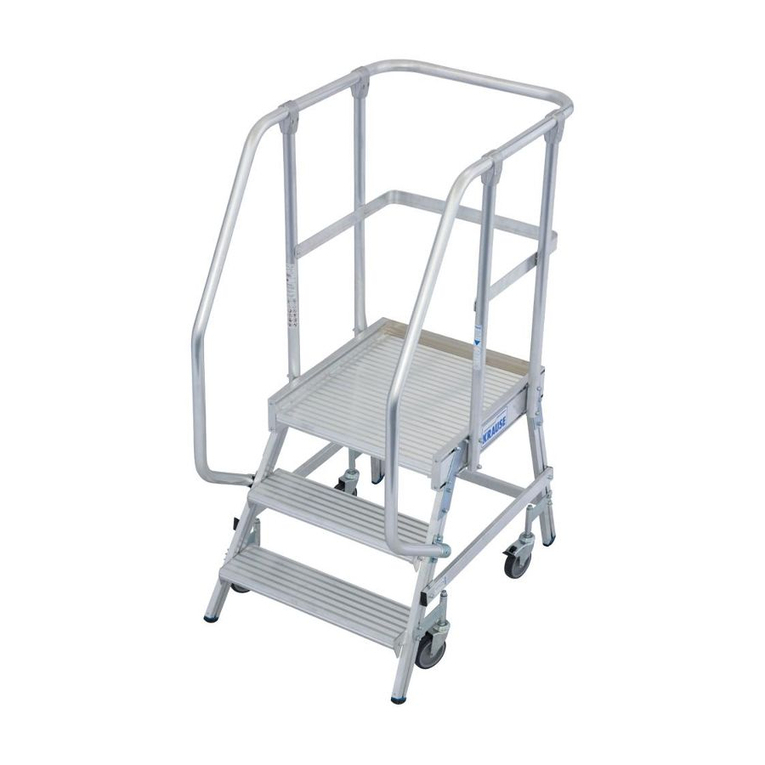
KRAUSE
KRAUSE 820136 Assembly instructions and user's manual
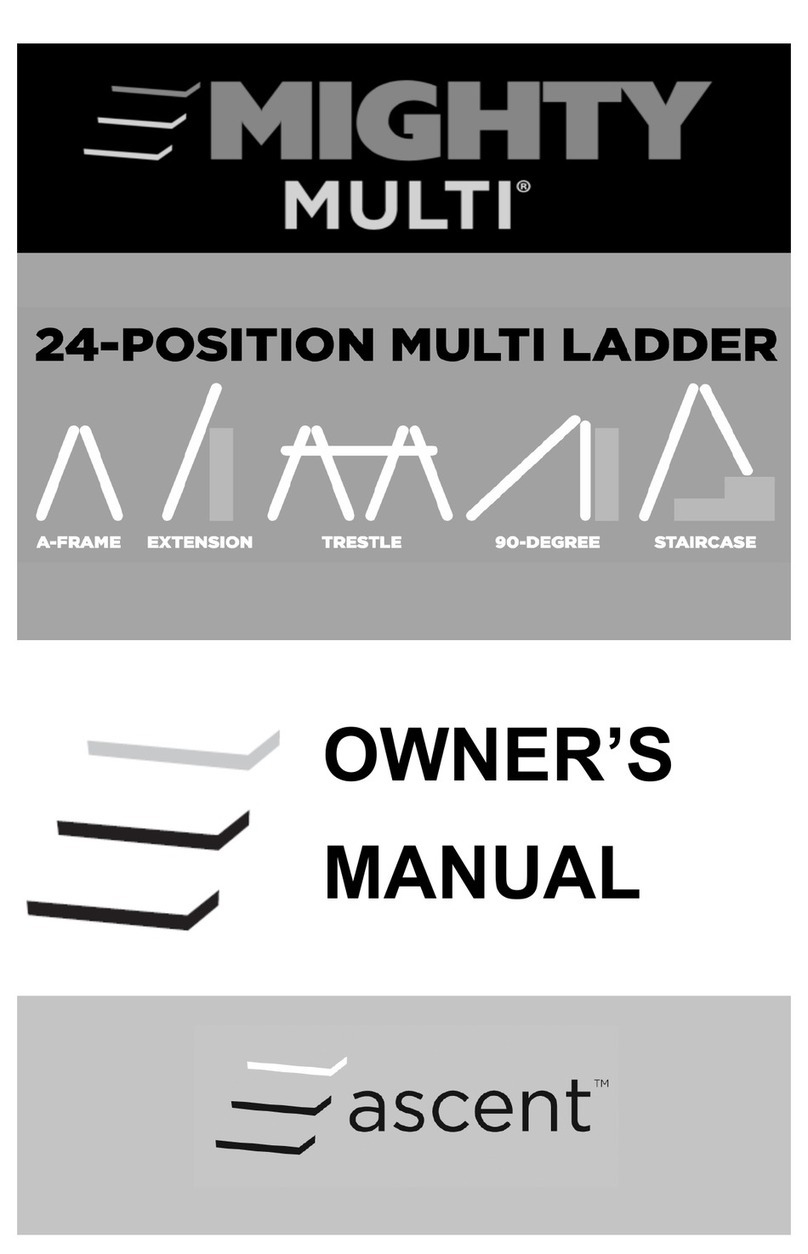
Ascent
Ascent MIGHTY MULTI owner's manual

Great Northern Docks
Great Northern Docks 9079DL Assembly instructions
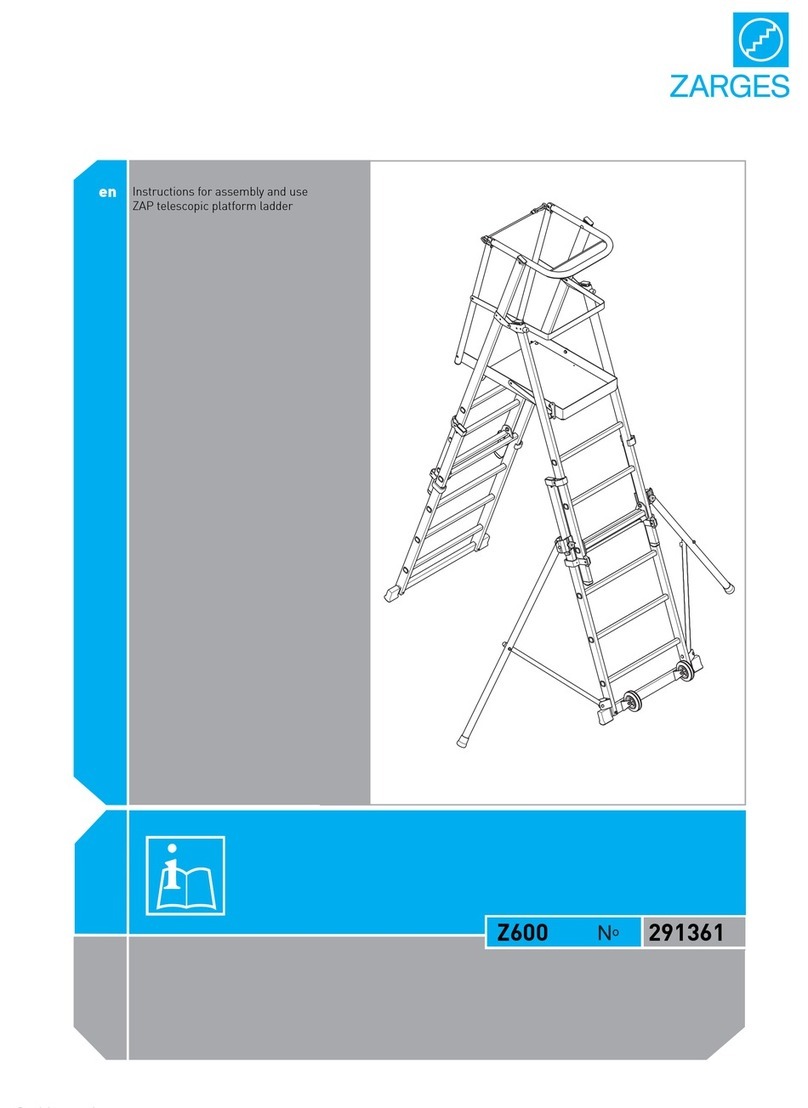
zarges
zarges ZAP Z600 Instructions for assembly and use

PiggyBack
PiggyBack ADJ-4 Owner Assembly & Use Manual
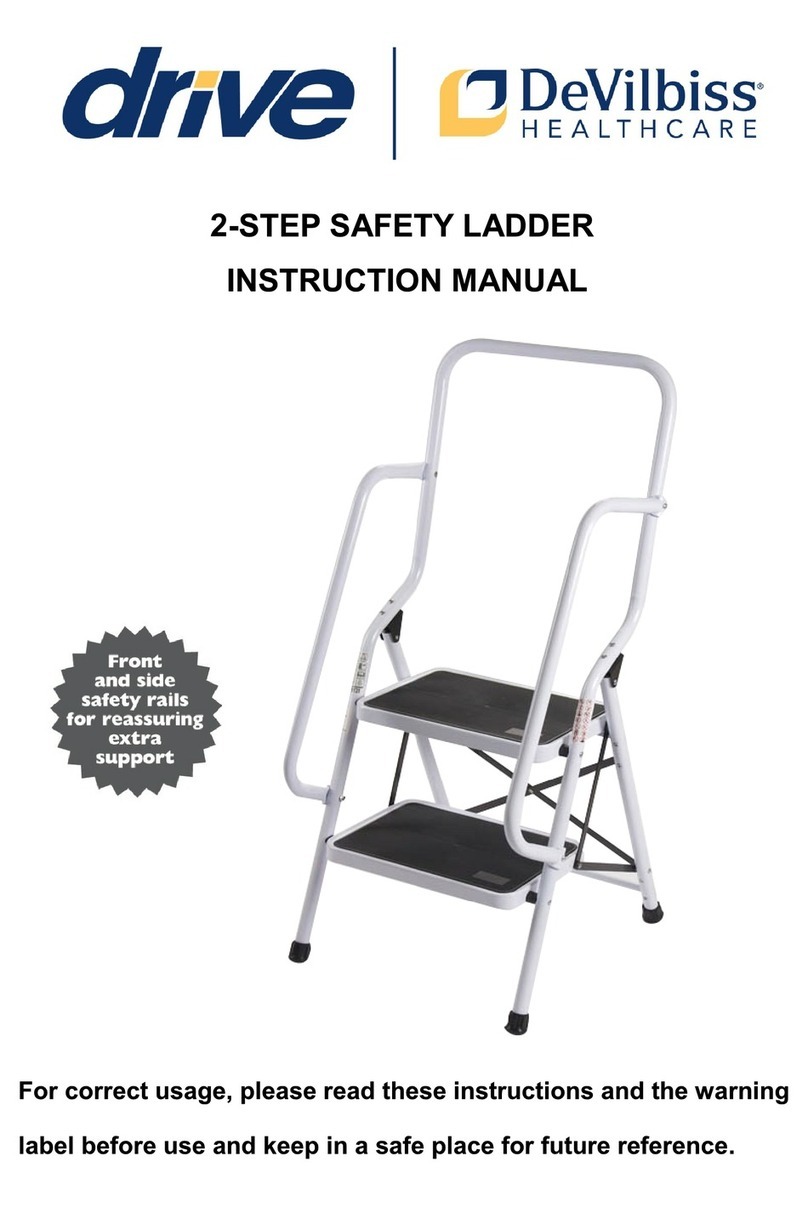
Drive DeVilbiss
Drive DeVilbiss Two Step Safety Ladder instruction manual
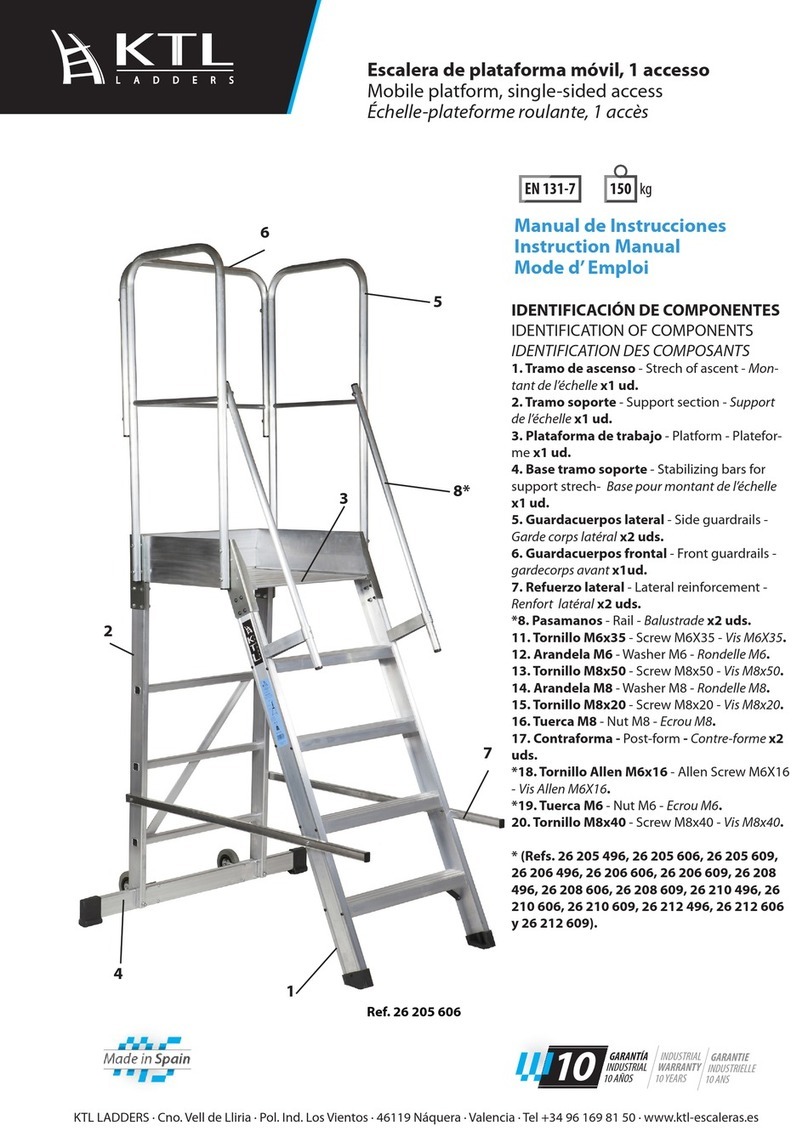
KTL
KTL EN 131-7 instruction manual

Sapa
Sapa REDD Team Dura-Grip OSHA Assembly
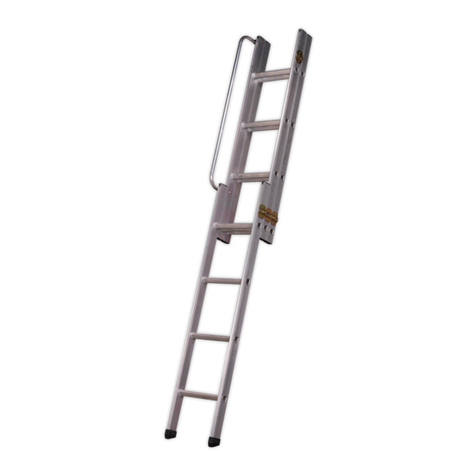
Sealey
Sealey LFT03 Instructions for use
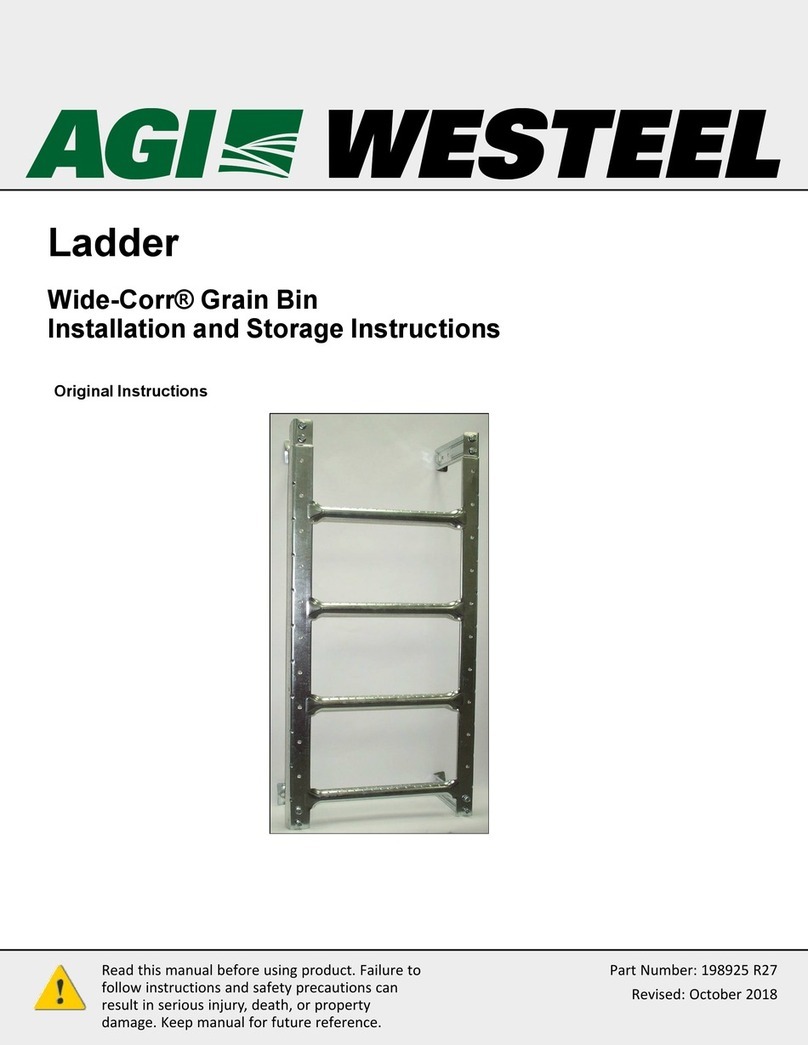
AGI
AGI Westeel Wide-Corr Installation and Storage Instructions

